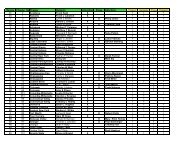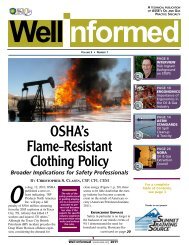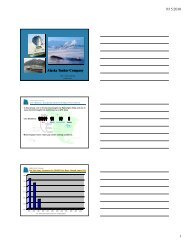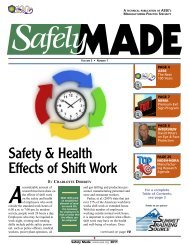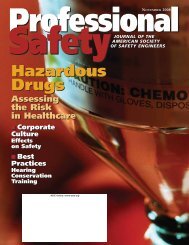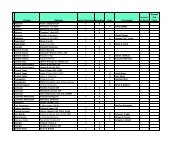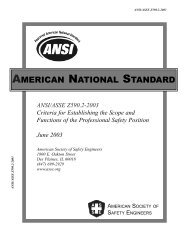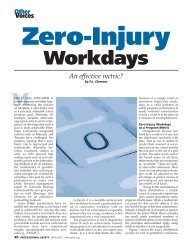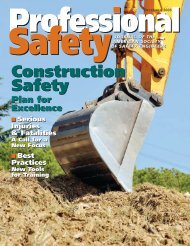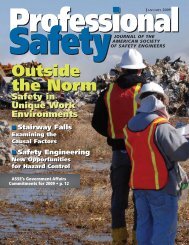Safety 2008 - ASSE - American Society of Safety Engineers
Safety 2008 - ASSE - American Society of Safety Engineers
Safety 2008 - ASSE - American Society of Safety Engineers
You also want an ePaper? Increase the reach of your titles
YUMPU automatically turns print PDFs into web optimized ePapers that Google loves.
IndustryNotesMSA’s Cranberry, PA,plant received VPPStar site status forexceeding safetyrequirements.INDUSTRY AWARDMSA Plant Named VPP Star SiteMSA’s manufacturing plant in Cranberry, PA, wasrecently designated as a national VoluntaryProtection Programs (VPP) Star site. Noteworthyachievementsinclude maintainingan accident rate56% below theindustry averagefor the past 3 years;achieving a totalcase incident rate <strong>of</strong>51%, which isbelow 2005 averages;having 52%less than the industryaverage <strong>of</strong> caseswith days awayfrom work, restricted activity or job transfer; andmore than 50% employee participation on designatedsafety teams.Two years ago, employees decided to make VPPcertification a continuous improvement initiative,with a goal <strong>of</strong> exceeding the requirements. “Simplyput, as safety improves, everyone wins—ouremployees, our customers and our shareholders,”says Bill Lambert, MSA president. The Cranberryplant is MSA’s primary North <strong>American</strong> manufacturingsite for portable and permanent gas detectioninstruments, thermal imaging cameras,chemical detection instruments, printed circuitboards, self-contained breathing apparatus accessoriesand integrated communication headsets forthe military and custom application systems. Formore information, visit www.msanet.com.INCIDENT INVESTIGATIONCSB Releases Final Report& Video on Barton SolventsExplosionU.S. Chemical <strong>Safety</strong> and Hazard InvestigationBoard (CSB) released a case study and safety videoon the July 2007 explosion and fire at the BartonSolvents facility in Valley Center, KS. CSB foundthe probable cause to be a nonconductive flammableliquid that sparked from a loosely linked levelmeasuringfloat within the tank, igniting thevapor-air mixture inside the tank as it was beingfilled. CSB reports that nonconductive flammableliquids can accumulate and maintain static electricalenergy that discharges more slowly than frommore conductive liquids, and that some liquids canform ignitable vapor-air mixtures inside tanks,which can explode if a spark occurs. To help companiesunderstand this type <strong>of</strong> hazard, CSB hasreleased a 10-minute safety video that features acomputer animation depicting the events leadingup to the incident.During the investigation, CSB reviewed morethan 50 MSDS for some <strong>of</strong> the most widely used14 PROFESSIONAL SAFETY AUGUST <strong>2008</strong> www.asse.orgnonconductive flammable liquids in the industry,most <strong>of</strong> which failed to recommend specific precautionsbeyond bonding and grounding. “The accidentat Barton Solvents emphasizes the need foraccurate and detailed MSDS,” says CSB BoardMember William Wark. He says although theMSDS warn about the dangers <strong>of</strong> accumulatingstatic electricity, they fail to warn specifically thatthey can be ignited in storage tanks. CSB recommendsthat OSHA and others improve requiredinformation contained in MSDS to include addressingnonconductive flammable liquids, and that sixmajor oil and chemical industry associations asktheir member companies to improve the warningson the MSDS <strong>of</strong> flammable liquids. CSB also suggeststhat companies that handle these liquidsshould obtain more detailed technical informationon them, purge storage tanks with an inert gas toremove oxygen, add antistatic agents to the liquids,pump liquids more slowly and verify that storagetank level floats are effectively bonded. For moreinformation, visit www.csb.gov.MINE SAFETYMSHA Distributes PublicService AnnouncementsMSHA is distributing the ninth volume <strong>of</strong> Mine<strong>Safety</strong> Minutes, a series <strong>of</strong> audio public serviceannouncements aimed at educating miners andmine operators about workplace hazards. The newvolume contains twelve 1-minute messages aboutmine safety and health issues that provide advice,warnings and updates on safety issues. “Theseaudio messages have become an extremely effectiveway for communicating critical mine safety andhealth information directly to working miners,”says Richard Stickler, MSHA acting administrator.“We hope that local radio stations air these messages<strong>of</strong>ten as a public service to working miners intheir communities.”Topics include black lung prevention, mineemergency management requirements, accidentprevention techniques, adequate training and theMINER Act. Four <strong>of</strong> the messages have themesapplicable to coal mining audiences. The remainingeight are geared toward audiences in communities’metal and nonmetal mines, quarries, and sand andgravel pits. The messages may be heard at www.msha.gov.DISASTER RECOVERYOSHA Creates Flood &Tornado Recovery WebsiteOSHA’s new floods and tornadoes recovery webpage, at www.dol.gov, aims to benefit employersand employees involved in cleanup and recoveryactivities following the recent Midwest disasters.According to OSHA, the page features links tomore than 40 factsheets and easy references withsafety and health tips on hazards such as downedelectrical wires, decontamination and heat and sun.



